Birkinshaw's Four Dimensions of Management
Management is a complicated topic that takes on a variety of roles and functions within any organization. If you work as a manager in some capacity, you understand just how flexible you need to be in order to accomplish your objectives successfully. One of the challenges that comes with being a leader is deciding just how to go about your job and what management styles are going to be most successful for you in your organization. While some of your style is likely to be 'natural' to you, other parts of it you might have to work at until your find a method that you are comfortable with.
Birkinshaw's Four Dimensions of Management take a look at four different areas that managers need to deal with, and what kind of approach will work for each of them.
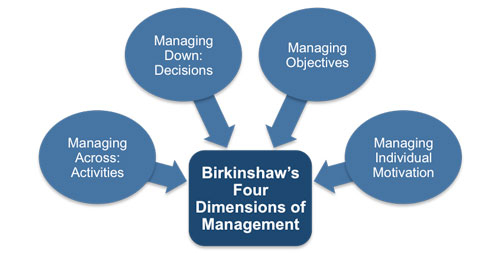 |
Rather than offering up strict guidelines, this framework is meant to get you thinking about your own style and then to decide for yourself which way is going to be best. The four dimensions are as follows -
- Managing Across: Activities. This refers to lateral management of people that you don't necessarily have control over from a leadership perspective.
- Managing Down: Decisions. This is more of what you think about when thinking of leadership - making decisions that affect a number of different people in different roles.
- Managing Objectives. How are goals accomplished within the organization? There are a number of ways to chase down and accomplish various goals depending on what will work best for the leader and the team members.
- Managing Individual Motivation. Possibly the most difficult part of leadership, keeping individual members of the team motivated from start to finish is crucial.
Within each of these dimensions, Birkinshaw offers two 'extremes' that form a scale for management style. Most organizations will fall somewhere within the limits of the scale, blending each of the styles that is represented on the far ends. One end of the scale is meant to represent the 'traditional' style of management', while the other is more 'alternative'. Let's look closer at each of these limits with the dimensions of management.
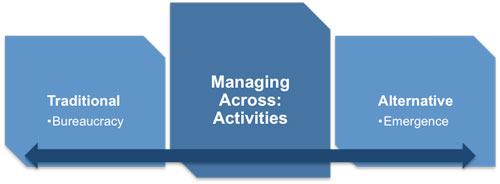 |
Managing Across: Activities
On one end of this dimension we have bureaucracy, and on the other end is emergence. As you would imagine, bureaucracy is the traditional form of management in this case. With this style, most of the management is dictated by strict rules and guidelines that have been put in place to govern the whole organization. There is very little room for creativity or flexibility built in to a bureaucratic environment, but it can be effective when consistency is valued above all else.
Emergence is the opposite of bureaucracy, in that much of the power is put into the hands of the individual managers to be independent. Most people would prefer working under these conditions as they are free to make more choices and not live by the rules that have been set forth. However, emergence isn't going to be the best choice for all organizations as it could potentially lead to a chaotic feeling throughout the company.
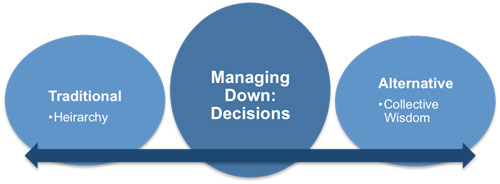 |
Managing Down: Decisions
The two ends of the spectrum under this dimension are hierarchy and collective wisdom. Traditionally, hierarchy is the way that most organizations manage to make decisions. Authority trumps everything else in this situation, so the higher ranking person will win out in any disagreement or dispute. This is the classic 'climbing the ladder' scenario, where employees put in their time early in their careers to later achieve management positions and the power that comes with them. Unfortunately, what can be lost in this style are the good ideas that those lower in the hierarchy might have to offer. Suppressing good ideas simply because of where they come from could hurt the organization in the long run.
The alternative to this style is collective wisdom, where everyone is welcome to help make decisions and offer up ideas. Naturally, those lower in the organization will appreciate this method, although it may discourage motivation to climb the ladder and achieve a position of power. Also, decisions can be slow and tedious to come by when there is input from so many different sources.
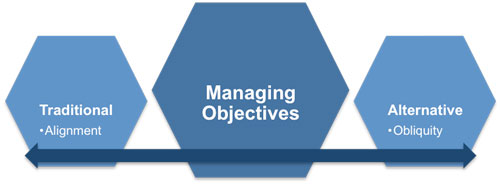 |
Managing Objectives
In this dimension, organizations will fall somewhere between alignment and obliquity. Alignment is the traditional method of goal setting, and the one that most managers tend to use because it is easily understood. Setting a specific financial goal or completion date for a project is an example of alignment, and then everyone on the team is tasked with working specifically toward accomplishing that goal.
Obliquity, on the other end, is a less-direct method of goal setting. Instead of working toward that specific financial goal that the organization has in mind, the team will instead be given other goals that will hopefully lead the organization in the right direction as a result. Creativity is promoted under this style of management, as the team members have the freedom to chart their own path in terms of reaching the goals that have been set (or that they have set for themselves).
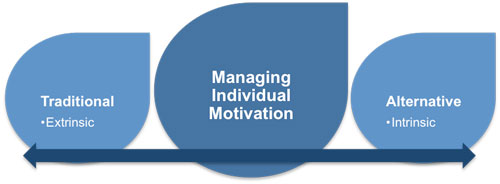 |
Managing Individual Motivation
Motivation can be a tricky thing to keep track of, let alone manage. Every individual is a different person, with different motivating factors in mind, and different goals for their life. The two ends of this scale are extrinsic and intrinsic. The most common motivating factor at work is extrinsic - usually meaning money. While a bonus or pay raise is usually the extrinsic motivation for getting the job done right, those motivators can also be negative, such as the threat of losing a job or being demoted.
Intrinsic motivation can actually be even more powerful than extrinsic, but it is harder to understand because it changes so much from person to person. While almost anyone will be motivated by the opportunity to earn more money, the things that motivate them intrinsically can be harder to pinpoint. What would be naturally motivating to one person might not be rewarding at all to another. Finding the right balance of motivating factors for each of your team members is an important part of management.
You may also be interested in:
Mintzberg's Management Roles | Lencioni's Five Dysfunctions of a Team | Birkinshaw's Four Dimensions of Management | Waldroop and Butler's Six Problem Behaviors | Cog's Ladder | Leader-Member Exchange Theory | Belbin's Team Roles | Benne and Sheats' Group Roles | Margerison-McCann Team Management Profile | The JD-R Model.



